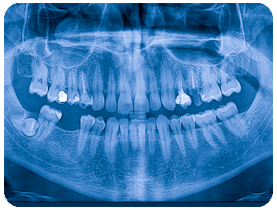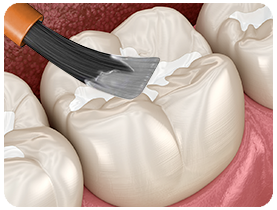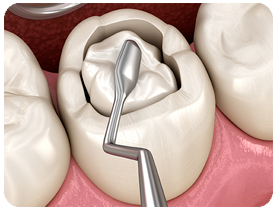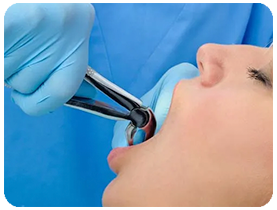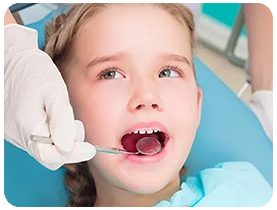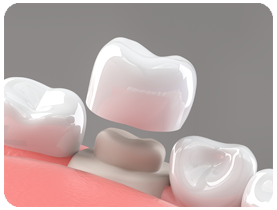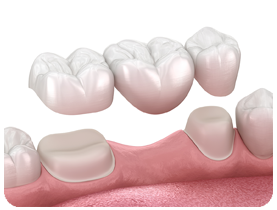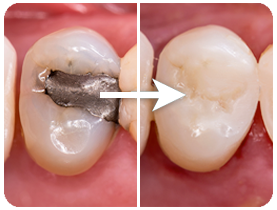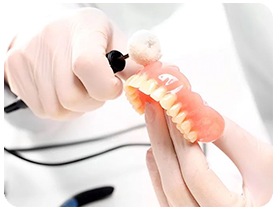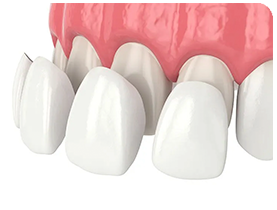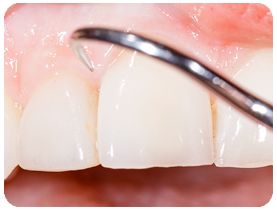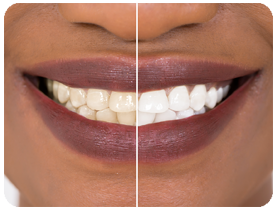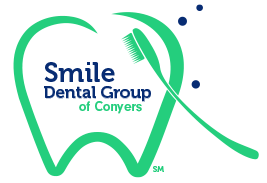
Services
Complete Oral Exams
A thorough exam of your teeth and gums by a dentist every six months is an essential part of maintaining a healthy smile. Not only do dentists look for the obvious problems, like cavities, but they can detect the early signs of much more serious problems such as periodontal disease and mouth and throat cancer. To provide a complete evaluation or your condition it is necessary for the dentist to review current X-rays of your teeth to identify any problems that would be undetectable by a visual exam.
When dental problems are spotted early, they are much easier to resolve quickly. Catching the problem early ultimately saves you time and money, and keeps you pain free. These preventative benefits make oral exams well worth the effort.
Cleanings
Regular check-ups and cleanings every six months go a long way toward preventing cavities and gum disease and eliminating other problems such as sore, bleeding gums or persistent bad breath. Our hygienists are meticulous about removing the plaque and calculus that naturally build up in the mouth over time, and they will teach you how to take care of your smile at home to keep it bright and healthy. If it’s been over six months since your last check-up, call us today to schedule a cleaning appointment.
Full Diagnostic X-rays
Our office has the capacity to take a complete series of diagnostic X-rays of your mouth to allow our dentists to identify oral problems that would be undetectable by a visual examination. We employ the use of digital panoramic X-ray and digital bitewing X-ray machines to obtain a complete picture of your teeth, gums and oral cavity.
Thanks to new digital technology, we can take X-rays of your mouth that use 90 percent less radiation that standard film X-rays. In addition, digital X-rays are immediately transmitted to a computer screen in our treatment room, so you don’t have to spend your valuable time waiting for your X-rays to be developed. Instead, you can see the images of your teeth instantly, and computer technology allows the X-rays to be enlarged, highlighted, inverted or even colorized, helping you and your dentist see hard-to-spot dental problems.
Sealants
Sealants are a revolutionary application that helps protect children’s teeth from decay. All molars have deep grooves on the chewing surface, which can easily trap food, promoting decay. Children start getting their first permanent molars around age six or seven, and by age 13, they have all of their back teeth that need to be sealed.
To “seal” a tooth, a thin, tooth-colored, liquid acrylic coating is applied to the grooves on the surface of the molar and then bonded to the tooth with a high-intensity light. The sealant alters the biting surface of the tooth just enough so that food cannot easily become trapped on the tooth surface, thus protecting the tooth from future decay. The process is simple, painless and takes only a few minutes to perform in our office. We can place sealants on your child’s back permanent teeth as they erupt, usually during their routine cleaning appointment.
Fillings
Early detection of cavities is essential to halt decay and stop the loss of tooth structure. The earlier cavities are detected, the smaller and stronger the fillings used to close them will be.
With growing concerns over mercury, the days of silver amalgam fillings are coming to an end. Our dentists use natural looking, tooth-colored composite resins to fill cavities caused by tooth decay. These sophisticated resins are strong, esthetically pleasing, do not discolor over time, and have similar expansion and contraction rates to normal tooth structure. We offer local anesthesia to minimize discomfort for our patients during most cavity treatments.
Extractions
Teeth may need to be removed for a number of different reasons: extensive decay, advanced periodontal disease, infection, or trauma. In many cases, we are able to evaluate and treat you during the same visit. If your medical history is complex or you are taking a number of prescribed medications, we may need to discuss your medical history with you before beginning treatment. Our dentists perform both simple and surgical extractions.
• Simple Extraction– minimally invasive procedure in which the entire tooth is removed without the need for extensive excavation of surrounding gum tissue. This is the most common type of extraction for fully erupted primary or permanent teeth.
• Surgical Extraction– more involved procedure involving extensive excavation of surrounding gum tissue and often sectioning of the tooth for complete removal. This method of extraction is often necessary for partially erupted, impacted, or broken teeth.
After any extraction, we will provide you with post-operative instructions, extra gauze and prescriptions, if needed. Someone from our office will call to check on you that evening to make sure everything is okay and to answer any questions you might have. You can expect some mild discomfort and minor swelling for a few days following surgical extractions. Most patients begin to feel better after a couple of days. Please remember that we are available after your surgery in case you have any questions or concerns.
Children’s Services
Our dentists, hygienists and assistants all have extensive experience working with children. Our goal is to provide quality, non-threatening service to our young patients and to equip them with the education to allow them to achieve optimum oral health and have an attractive, radiant smile for life!
We like to start seeing children at age three, before they get their first set of permanent molar teeth. We strive to make these early visits fun and informative for the children and parents, to show children that there’s no need to be afraid of the dentist and to establish a cooperative mindset for future dental care.
Our children’s office has colorfully decorated, kid-friendly waiting areas and treatment rooms that allow children to relax with others their age and feel comfortable among the whimsical themes and playful environments our murals depict. We perform a complete range of children’s dental services, including:
• Sealants
• Composite Fillings
• Extractions
• Space Maintainers
• Fluoride Treatment
• Pulpotomies
• Chrome-Steel Crowns
Crowns
When the damage to a tooth is too extensive for a simple filling, a crown is often used. Dental crowns are porcelain or metal forms molded to the shape of your tooth and attached with adhesive. Crowns restore the appearance and function of your natural teeth, as well as keep your jaw and bite aligned, ensuring that other teeth don’t shift locations or take on a greater share of the work of biting and chewing.
Dental crowns may be made of porcelain, gold or stainless steel. Porcelain crowns are the most cosmetically appealing choice since they are color-matched to the exact shade of your other teeth and porcelain has the same light-reflecting qualities and texture as tooth enamel. Gold crowns are sometimes selected for molars, since they are less noticeable further back in the mouth. Crowns made of stainless steel (often called “chrome-steel crowns”) are not designed for long-term use and are generally reserved for use on children’s primary teeth.
Bridges
A bridge is a special type of dental restoration that spans the space between missing teeth. To create a bridge, the teeth on either side of the gap are crowned, and an artificial tooth (or teeth) is inserted in between. As is the case with crowns, these false teeth can be made from porcelain, gold or other materials.
Filling Replacement
Many adults have silver amalgam fillings that are worn out, discolored, cracked, or that they simply want to replace with more natural-looking fillings. Our dentists can replace your silver fillings with natural-looking, tooth-colored composite resins. These sophisticated resins are strong, esthetically pleasing, do not discolor over time, and have similar expansion and contraction rates to normal tooth structure. We offer local anesthesia to minimize discomfort for our patients during filling replacements.
Dentures
When several teeth are missing, dentures are a great option to restore both function and appearance. Our practice offers both partial and complete dentures to help meet your needs.
• Partial Dentures – A partial denture is a removable set of artificial teeth attached to a metal framework that blends naturally with your existing teeth. These dentures help fill in gaps caused by missing teeth while preventing your remaining teeth from shifting out of place. They’re designed for comfort and ease of use, allowing you to maintain a natural look and enjoy better chewing ability. Partial dentures are ideal for those who still have some natural teeth remaining, and they can be adjusted over time for a perfect fit.
• Complete Dentures – If all the teeth in an upper or lower arch are missing, our complete dentures can restore your smile and improve your ability to speak and chew. Made from durable materials that resemble natural teeth, these dentures are custom designed to fit your mouth comfortably. While complete dentures are removable for easy cleaning, they provide a secure and natural look, helping you regain your confidence and quality of life. Our team will work closely with you to ensure that your dentures fit well and feel comfortable.
Both partial and complete dentures are great solutions for those looking to restore lost teeth, and we are here to guide you through every step of the process, from fitting to adjustment, ensuring a smile that works for you.
Veneers
Veneers are wafer-thin layers of custom-fitted, tooth-colored material that cover the front of the teeth. They can be used to conceal badly stained teeth and to correct misshapen, gapped, or chipped teeth. There is no need to put up with these embarrassing conditions any longer. Veneers can dramatically improve your smile with very little removal of tooth structure.
• Composite Veneers – The major advantage of composite veneers is treatment time. Composite veneers can often be applied in just one visit. The tooth surface is prepared, an adhesive is applied, and the veneer is bonded to the tooth surface. It is then polished and smoothed to look and feel like your natural teeth. Composite veneers, while convenient, are not as durable as porcelain veneers, may discolor over time and require periodic inspection by a dentist.
• Porcelain Veneers – Porcelain veneers usually require two or more visits to apply, but they are much stronger than composite veneers and more resistant to staining. Porcelain veneers can be used in a greater variety of situations than composite veneers and the dentist has more control over their shape and color (since they are made outside of the mouth). Porcelain has the same light-reflecting qualities and texture as tooth enamel, giving porcelain veneers a very life-like appearance.
How porcelain veneers are applied:
• At your first visit, your teeth are prepared, and an impression is made of them. Temporary veneers are made out of plastic and placed on your teeth to protect them while a model of your final veneers is being made.
• You can use your temporary veneers to evaluate the look and feel of your “new” teeth and review your model with a dentist, so that any changes you desire can be incorporated into your permanent veneers.
• Once you are happy with the appearance of your model, your final porcelain veneers are fabricated in a dental laboratory.
• At your final appointment, the dentist removes your temporary veneers, bonds the porcelain veneers to your teeth and blends the veneers with the remaining tooth structure, making it unnoticeable to the naked eye and completing your smile makeover.
Cosmetic Bonding
If you have minor problems with your smile including stained, crooked, or chipped teeth, dental bonding is a quick, easy way to make your teeth look flawless again. Dental bonding uses natural tooth-colored resins that are applied to existing teeth to hide slight cosmetic flaws or repair minor injuries. The resin is color-matched to your teeth, applied in thin layers and cured with a high-intensity light. It is sculpted to fit your tooth perfectly and finely polished to deliver the bright shine of a natural tooth.
Teeth Whitening
Bleaching or whitening your teeth is one of the simplest and most inexpensive ways to recapture that long, lost, bright smile. Teeth can become discolored with age for several reasons. Minerals, tobacco, antibiotics, certain foods, coffee and other beverages can stain teeth over time. We offer two different options for patients who want to reverse the effects of time and have a whiter, healthy-looking smile again.
Bleaching trays are customized mouthpieces made in our office from actual impressions of your teeth. You simply apply the bleaching gel we provide to the trays and wear them for a few hours each day. You choose the most convenient time and place to wear your bleaching trays.
We also sell professional strength Crest Whitestrips® for patients who do not want to have custom bleaching trays made.
The whitening process works the same with either method; stains are removed by the gentle oxygenating action of the peroxide carbamide gel. Most people require three to four weeks for their teeth to fully whiten, but they notice their teeth getting whiter in just three to four days!
Many patients ask us if whitening is safe. Yes, extensive research and clinical studies indicate that whitening your teeth under the supervision of a dentist is safe. In fact, many dentists consider whitening the safest cosmetic dental procedure available.
Non-Surgical Gum Therapy
Gum disease is a common dental problem among adults. Up to 80% of people suffer from some degree of gum disease at one time or another. Mild gum disease is commonly referred to as gingivitis, while severe gum disease is called periodontitis (or periodontal disease). In its earliest stages, gum disease may produce only mild symptoms – many people who have mild to moderate gum disease don’t even know they have it. As the condition progresses, symptoms become much worse, more painful, and may ultimately cause tooth loss. The good news is that periodontal disease is preventable through proper brushing and flossing and regular visits to your dentist.
Advanced stages of periodontal disease require special attention by a dentist. Our dentists can examine the pockets between your teeth and gums to determine the extent of gum disease present. If necessary, our hygienists can perform a procedure commonly called a “deep cleaning,” in which the plaque and calculus that have built up in these pockets below the gum line are removed. We provide local anesthesia during this type of cleaning for your comfort.
Common signs of periodontal disease include the following: bleeding gums, soreness or redness of gum tissue, swelling of gums around teeth, persistent bad breath, receding gums or loose teeth. If you have any of these symptoms, call our office to schedule a periodontal exam.





